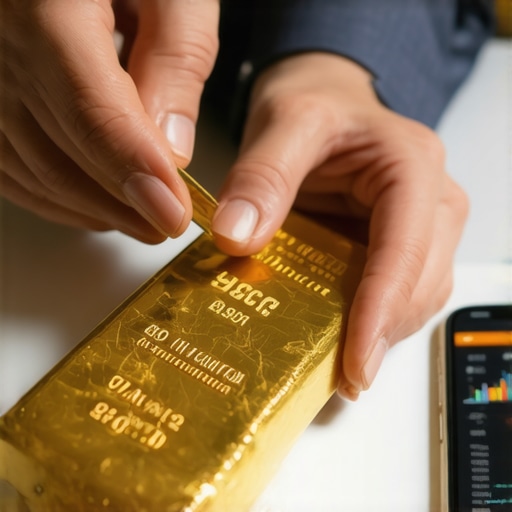Unlocking the Power of Gold IRAs: A Secure Path to Retirement Growth
Investing in gold IRAs has emerged as a compelling strategy for securing and growing retirement savings amid economic uncertainties. Unlike traditional IRAs, gold IRAs allow investors to diversify their portfolios with physical gold or gold-related assets, offering a hedge against inflation, currency fluctuations, and market volatility. For individuals aiming to fortify their retirement nest egg, understanding how to start investing in gold IRAs is essential for long-term financial resilience.
Decoding the Mechanics: What Makes Gold IRAs Stand Out?
Gold IRAs function as self-directed IRAs, enabling holders to include IRS-approved precious metals such as gold bullion, coins, and bars. This alternative asset class complements stocks and bonds by providing intrinsic value and stability. The IRS mandates specific purity standards and storage requirements, ensuring the gold held in these accounts maintains quality and security. This regulatory framework enhances trustworthiness while offering a tangible asset not subject to company defaults or bankruptcies.
How Do You Begin Investing in Gold IRAs to Maximize Retirement Growth?
Starting with a gold IRA involves several critical steps. First, select a reputable custodian specializing in self-directed IRAs that support precious metals. Next, open the account and fund it through a rollover or transfer from an existing retirement account. Then, choose the type of gold investment—coins or bullion—that fits your investment goals. Engaging with trusted dealers is paramount to ensure authenticity and fair pricing. Finally, arrange for secure storage in an IRS-approved depository to comply with regulations.
For newcomers, a detailed beginner’s guide to gold IRAs provides indispensable insights on navigating this process.
Balancing Portfolio Stability: Why Gold IRAs Are a Strategic Hedge
Gold’s historical performance as a safe haven during economic downturns is well-documented. By integrating gold IRAs into retirement portfolios, investors can mitigate risks posed by inflation and market turbulence. Unlike paper assets, gold maintains purchasing power over time, making it an effective shield against currency devaluation. Additionally, gold’s low correlation with equities enhances diversification, reducing overall portfolio volatility.
Expert Tips for Navigating Gold IRA Investments with Confidence
Experience shows that timing and selection are crucial. Monitoring global gold demand trends and central bank purchases can provide signals for optimal entry points. For instance, central banks’ increasing gold reserves often precede price appreciation, reflecting broader economic shifts. Staying informed through authoritative market analyses, like those found at Buying Old Now, empowers investors to make strategic decisions.
Moreover, understanding the distinctions between gold coins and bars, and their respective liquidity and premiums, can influence long-term gains.
Engage with the Community: Share Your Gold IRA Investment Journey
Have you started investing in a gold IRA or are you considering it? Share your experiences, questions, or strategies in the comments below and join a community dedicated to smart retirement growth. Your insights could illuminate paths for fellow investors navigating this rewarding yet complex asset class.
Strategic Timing: Capitalizing on Market Cycles for Gold IRA Investments
One of the nuanced aspects of optimizing gold IRA returns involves understanding the cyclical nature of the gold market. Gold prices often react to macroeconomic indicators such as inflation rates, geopolitical tensions, and central bank policies. Investors who monitor these variables can better time their acquisitions to capture value appreciation. For example, during periods of heightened inflation or currency devaluation, gold prices tend to surge, making it an opportune moment to increase allocations in a gold IRA.
Furthermore, tracking central banks’ gold purchase trends can provide predictive insights. Central banks have been accumulating gold reserves steadily, signaling confidence in gold’s role as a reserve asset. As detailed in authoritative analyses like those on Buying Old Now, these purchases often precede broader market shifts, aiding investors in anticipating price movements.
Diversification within Gold IRAs: Beyond Physical Gold
While physical gold coins and bars form the cornerstone of most gold IRAs, diversification within the gold asset class itself can enhance portfolio robustness. Investors may consider adding gold mining stocks, gold ETFs, or mutual funds focused on gold to their retirement accounts. These instruments provide liquidity and the potential for dividend income, complementing the stability of physical gold.
However, it is essential to weigh these options carefully. Gold stocks carry company-specific risks, such as operational challenges and management decisions, which differ fundamentally from the intrinsic value preservation offered by bullion. A balanced approach can involve combining both physical gold holdings and gold-related securities, tailoring the portfolio to individual risk tolerance and growth objectives. Guidance on these strategies is available in resources like Investing in Gold Stocks vs Physical Gold.
What Are the Key Regulatory and Tax Considerations When Managing a Gold IRA Portfolio?
Understanding IRS regulations and tax implications is crucial for managing a gold IRA effectively. The IRS stipulates that only certain types of gold meet the purity criteria (generally 99.5% pure) for inclusion in an IRA. Additionally, physical gold must be stored in an approved depository, not at home, to maintain the tax-advantaged status of the account.
Tax treatment of distributions from a gold IRA follows standard IRA rules, where withdrawals after age 59½ are taxed as ordinary income unless the account is a Roth IRA variant. Early withdrawals may incur penalties. It is advisable to work with knowledgeable custodians and financial advisors well-versed in precious metals IRAs to navigate these complexities. For a comprehensive overview, the IRS official guidance and expert commentary such as those found on IRS Retirement Plans FAQs Regarding Precious Metals are invaluable.
Leveraging Market Analysis for Informed Gold IRA Investment Decisions
Deep market analysis enhances strategic decision-making in gold IRA investing. Monitoring supply and demand dynamics, geopolitical developments, and economic indicators allows investors to anticipate price trends. For instance, emerging market demand, particularly in Asia, continues to impact global gold prices significantly. Staying abreast of these trends through trusted platforms ensures investors can adjust their positions proactively.
Advanced investors also utilize technical analysis and gold futures market data to inform timing and sizing of investments. Combining fundamental and technical insights creates a comprehensive approach that aligns with long-term retirement goals. For those interested in expanding their skill set, exploring resources on Gold Trading Techniques can be particularly beneficial.
Have you explored how diversifying within your gold IRA portfolio or timing your investments based on market signals has impacted your retirement planning? Share your strategies and experiences in the comments to enrich this expert community. If you want to deepen your understanding, consider reading more about gold IRA benefits and investment options to refine your approach.
Harnessing Advanced Portfolio Diversification Within Gold IRAs: Beyond Conventional Assets
While traditional gold IRAs emphasize physical bullion and coins, sophisticated investors increasingly explore hybrid diversification strategies that blend physical assets with gold-backed securities. This nuanced approach allows for enhanced liquidity, potential dividend income, and tactical exposure to gold market dynamics. For example, integrating selective gold mining equities or exchange-traded funds (ETFs) alongside physical holdings can leverage market growth while preserving a safety net against volatility.
However, such diversification necessitates a deep understanding of risk profiles. Mining stocks, although correlated with gold prices, are subject to operational risks including geopolitical instability at mine sites, regulatory changes, and company management efficacy. Conversely, ETFs offer ease of trading and lower premiums but may lack the tangible security of physical gold. Balancing these asset types requires aligning with individual risk tolerance, investment horizon, and retirement goals.
Expert investors often employ a tiered allocation method, dedicating a core portion to IRS-approved physical gold stored securely, complemented by a satellite allocation in liquid gold instruments. This approach maximizes portfolio resilience while optimizing growth potential.
Deciphering Complex Tax and Regulatory Frameworks: Compliance and Optimization for Gold IRA Holders
Gold IRAs operate under stringent IRS guidelines that govern purity standards, storage, and reporting. The IRS mandates a minimum purity of 99.5% for bullion and allows only specific coin types recognized by the U.S. Mint or equivalent entities. Custodians must ensure gold is stored in approved depositories, which not only safeguard assets but also preserve the tax-advantaged status of the IRA.
Tax implications extend beyond simple income tax considerations. For instance, distributions from traditional gold IRAs are taxed as ordinary income upon withdrawal, which requires strategic planning to minimize tax burdens in retirement. Early distributions before age 59½ typically incur a 10% penalty, emphasizing the importance of long-term commitment.
Moreover, investors should be vigilant regarding potential pitfalls such as prohibited transactions, including taking physical possession of gold, which can jeopardize the account’s tax benefits. Engaging with custodians specializing in precious metals IRAs and consulting tax professionals experienced in this niche is indispensable.
For an authoritative resource, the IRS Retirement Plans FAQs Regarding Precious Metals provide detailed regulatory insights essential for compliance and optimization.
How Can Investors Navigate the Intricacies of Gold IRA Custodian Selection to Ensure Regulatory Compliance and Maximize Returns?
Choosing a custodian is arguably one of the most critical decisions in managing a gold IRA. Custodians are responsible for account administration, compliance with IRS regulations, and coordinating secure storage. Investors must evaluate custodians based on their experience with precious metals IRAs, fee structures, transparency, and customer service responsiveness.
Due diligence includes verifying the custodian’s licensing, reputation, and partnerships with IRS-approved depositories. A well-chosen custodian not only safeguards assets but also provides valuable advisory services that can help optimize investment timing and asset selection.
Engaging with expert reviews and industry rankings can further inform this decision. Resources such as Investopedia’s Guide to Gold IRA Custodians offer comprehensive evaluations tailored to investor needs.
Integrating Macro-economic Indicators and Geopolitical Analysis for Proactive Gold IRA Management
Seasoned investors recognize that gold prices are inextricably linked to global economic trends and geopolitical events. Inflation rates, monetary policy shifts by central banks, currency stability, and international conflicts exert profound influence on gold’s market trajectory.
For instance, dovish central bank policies and quantitative easing typically increase inflation expectations, often leading to gold price appreciation. Conversely, strong economic growth and rising interest rates may dampen gold’s appeal as an inflation hedge.
By incorporating real-time macroeconomic data, geopolitical risk assessments, and central bank reserve activities into their investment frameworks, gold IRA holders can anticipate market inflection points and strategically adjust their portfolios.
Advanced analytical tools and subscription-based market intelligence services provide granular insights, enabling investors to stay ahead of trends rather than merely reacting. Such proactive management can materially enhance long-term portfolio performance.
Have you leveraged sophisticated market indicators or specialized custodians to amplify your gold IRA strategy? Share your experiences or questions below to contribute to our expert community. For further mastery, explore our in-depth analysis on gold IRA benefits and strategic investment options.
Elevating Gold IRA Success: Selecting Custodians with Precision and Expertise
In the complex landscape of gold IRA management, discerning investors recognize that choosing the right custodian is a pivotal decision that directly impacts regulatory compliance and portfolio performance. Custodians serve not only as administrators but also as gatekeepers ensuring adherence to IRS standards and safeguarding physical assets within approved depositories. An expert custodian offers transparent fee structures, robust security protocols, and proactive guidance on asset selection, storage logistics, and distribution strategies.
Given the nuanced regulatory environment, investors must rigorously vet prospective custodians by confirming their licensing credentials, experience with precious metals IRAs, and reputation for timely, responsive customer support. Leveraging third-party evaluations and authoritative industry rankings can illuminate the best options tailored to specific investment goals. For an exhaustive analysis of top-tier custodians, consult resources like Investopedia’s Guide to Gold IRA Custodians.
Tax Nuances and Compliance: Navigating the Regulatory Labyrinth with Confidence
Gold IRAs operate under a stringent regulatory framework that demands precise adherence to purity standards, storage mandates, and distribution protocols. The IRS requires physical gold to meet or exceed 99.5% purity and be held exclusively in IRS-approved depositories, precluding personal possession to preserve tax-advantaged status. Missteps, such as unauthorized possession or prohibited transactions, can trigger severe tax penalties and compromise the IRA’s benefits.
Understanding the tax implications of withdrawals is equally crucial. Traditional gold IRAs impose ordinary income tax on distributions post age 59½, with early withdrawals incurring additional penalties. Strategic tax planning, often in collaboration with seasoned financial advisors, can optimize withdrawal timing to minimize tax liabilities, balancing income needs and regulatory constraints.
What Are the Emerging Analytical Tools That Empower Gold IRA Investors to Anticipate Market Movements Effectively?
Advanced investors increasingly harness sophisticated analytical platforms integrating macroeconomic data, geopolitical risk indices, and gold futures market dynamics to refine entry and exit strategies. These tools amalgamate real-time inflation metrics, central bank gold reserve activities, and technical chart patterns to forecast price inflection points with greater precision. Subscription-based intelligence services also offer sentiment analysis and scenario modeling to anticipate market shocks.
Utilizing these cutting-edge analytical resources enables proactive portfolio adjustments, mitigating downside risks while capitalizing on upward trends. For those seeking to deepen their expertise, detailed methodologies are explored in specialized publications such as Gold Trading Techniques.
Integrating Macro-Financial Indicators with Gold IRA Strategy: A Proactive Approach
Seasoned gold IRA investors incorporate a multi-dimensional analysis framework that includes inflation trajectories, currency fluctuations, and international political developments. By continuously monitoring central bank monetary policies, trade tensions, and fiscal stimulus measures, they anticipate shifts that influence gold valuation. This proactive stance transcends reactive investing, positioning portfolios to benefit from cyclical opportunities and to hedge against systemic risks.
Employing this approach demands a robust understanding of global macroeconomics and access to timely, accurate data feeds. Advanced subscription services and real-time analytics platforms facilitate this level of insight, empowering investors to optimize asset allocation dynamically.
Engage with Our Expert Gold IRA Community
Are you leveraging advanced custodial insights, tax strategies, or analytical tools to refine your gold IRA portfolio? Share your experiences, challenges, or questions in the comments below. Join a network of sophisticated investors committed to mastering the intricacies of gold IRAs and achieving resilient retirement growth.
Frequently Asked Questions (FAQ)
What exactly is a Gold IRA and how does it differ from a traditional IRA?
A Gold IRA is a self-directed individual retirement account that allows investors to hold physical gold and other IRS-approved precious metals as part of their retirement portfolio. Unlike traditional IRAs which typically hold stocks, bonds, or mutual funds, Gold IRAs provide diversification through tangible assets that can hedge against inflation and market volatility.
Which types of gold are allowed in a Gold IRA according to IRS regulations?
The IRS permits gold bullion and coins that meet a minimum purity of 99.5%, including certain American Gold Eagle and Canadian Gold Maple Leaf coins. Gold bars must be manufactured by accredited refiners. This ensures the physical metals in the IRA maintain quality and compliance for tax advantages.
How do I choose a custodian for my Gold IRA and why is this choice critical?
Selecting a custodian experienced in precious metals IRAs is crucial because they manage account administration, compliance with IRS rules, and coordinate storage logistics. A reputable custodian ensures your gold is held securely in approved depositories and helps avoid prohibited transactions that could jeopardize your tax benefits.
Can I personally store the gold from my IRA at home?
No. IRS regulations mandate that physical gold in IRAs must be stored in IRS-approved secure depositories. Personal possession or home storage of IRA metals is considered a prohibited transaction and can lead to penalties and loss of tax advantages.
What are the tax implications when withdrawing funds from a Gold IRA?
Distributions from traditional Gold IRAs are taxed as ordinary income after age 59½. Early withdrawals may incur a 10% penalty in addition to income taxes. Roth Gold IRAs provide tax-free withdrawals if conditions are met. Strategic planning with financial advisors can minimize tax exposure at distribution.
How can market analysis help me optimize the timing of my Gold IRA investments?
Monitoring macroeconomic indicators like inflation rates, central bank gold purchases, geopolitical tensions, and currency fluctuations can signal opportune moments to buy or adjust gold allocations. Utilizing technical analysis and futures market data further refines timing to maximize growth potential.
What are the benefits and risks of including gold mining stocks or ETFs in my Gold IRA?
Including gold-related securities offers liquidity and potential dividends, complementing physical gold’s stability. However, mining stocks are subject to company-specific risks such as management decisions and operational challenges. ETFs offer ease of trading but lack physical asset tangibility. A balanced approach tailored to risk tolerance is recommended.
Are there any penalties for improper transactions within a Gold IRA?
Yes, prohibited transactions such as taking physical possession of the metals, buying collectibles, or using the IRA assets for personal benefit can trigger severe IRS penalties, including disqualification of the IRA’s tax-advantaged status. Compliance and custodian guidance are essential to avoid these pitfalls.
How do central bank gold purchases influence Gold IRA strategies?
Central banks accumulating gold often indicate confidence in gold as a reserve asset and can precede price appreciation. Tracking these purchases helps investors anticipate market trends and adjust their Gold IRA allocations proactively to capture growth opportunities.
What advanced analytical tools are recommended for experienced Gold IRA investors?
Tools integrating real-time macroeconomic data, geopolitical risk indices, gold futures prices, and sentiment analysis provide sophisticated forecasting abilities. Subscription-based market intelligence platforms and technical charting software support strategic entry and exit decisions, effectively managing portfolio risk and maximizing returns.
Trusted External Sources
- Internal Revenue Service (IRS) – Retirement Plans FAQs Regarding Precious Metals: This official resource details regulatory requirements for gold IRAs, including purity standards, storage mandates, and tax implications, serving as the definitive compliance reference.
- Investopedia – Guide to Gold IRA Custodians: Provides comprehensive evaluations and comparisons of custodians specializing in precious metals IRAs, aiding investors in selecting reliable administrators aligned with regulatory standards.
- World Gold Council: Offers in-depth research and market analysis on gold demand, supply, and macroeconomic influences, invaluable for understanding gold’s role in portfolio diversification and timing strategies.
- LBMA (London Bullion Market Association): As a global authority on gold bullion standards and trading practices, LBMA sets benchmarks for quality and transparency crucial for investors seeking compliant and trustworthy bullion sources.
- Buying Gold Now (buyingoldnow.com): Specialized platform providing expert insights, market forecasts, and practical guides on gold IRA investing, including analysis of central bank trends, trading techniques, and diversification strategies.
Conclusion
Gold IRAs represent a sophisticated and effective avenue for diversifying retirement portfolios with a tangible asset that historically preserves value amid economic fluctuations. By understanding the rigorous IRS regulations, selecting expert custodians, and employing advanced market analysis, investors can strategically position their Gold IRAs for resilient growth and long-term security. Integrating physical gold with select gold-related securities allows tailored risk management aligned with individual goals.
Mastering the nuances of regulatory compliance, tax implications, and market timing empowers investors to confidently harness gold’s potential as a retirement hedge. We encourage readers to apply these expert insights, engage with the community by sharing experiences, and explore further authoritative resources to refine their Gold IRA strategies for a robust financial future.










